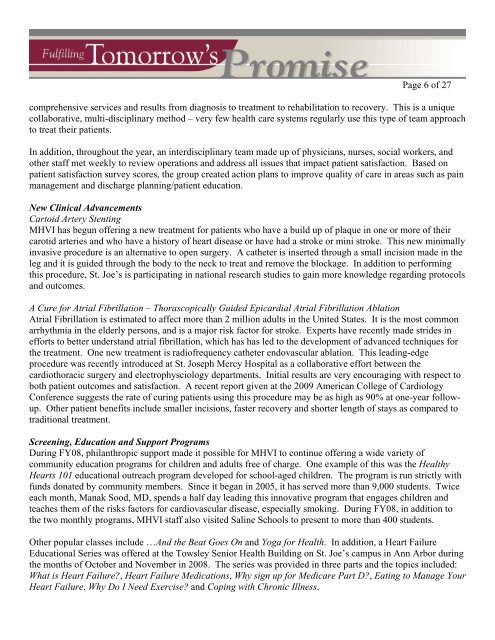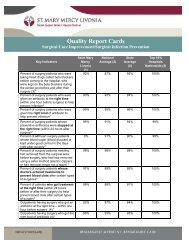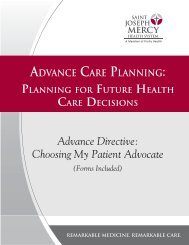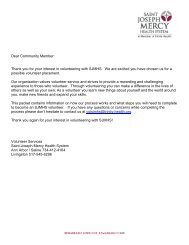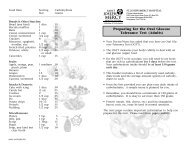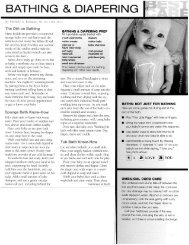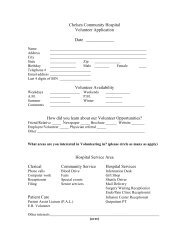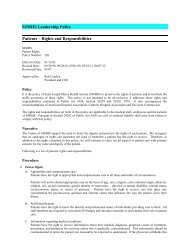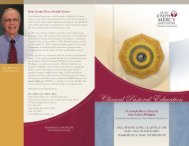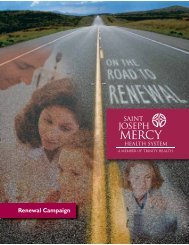Saint Joseph Mercy Health System
Saint Joseph Mercy Health System
Saint Joseph Mercy Health System
Create successful ePaper yourself
Turn your PDF publications into a flip-book with our unique Google optimized e-Paper software.
Page 6 of 27comprehensive services and results from diagnosis to treatment to rehabilitation to recovery. This is a uniquecollaborative, multi-disciplinary method – very few health care systems regularly use this type of team approachto treat their patients.In addition, throughout the year, an interdisciplinary team made up of physicians, nurses, social workers, andother staff met weekly to review operations and address all issues that impact patient satisfaction. Based onpatient satisfaction survey scores, the group created action plans to improve quality of care in areas such as painmanagement and discharge planning/patient education.New Clinical AdvancementsCartoid Artery StentingMHVI has begun offering a new treatment for patients who have a build up of plaque in one or more of theircarotid arteries and who have a history of heart disease or have had a stroke or mini stroke. This new minimallyinvasive procedure is an alternative to open surgery. A catheter is inserted through a small incision made in theleg and it is guided through the body to the neck to treat and remove the blockage. In addition to performingthis procedure, St. Joe’s is participating in national research studies to gain more knowledge regarding protocolsand outcomes.A Cure for Atrial Fibrillation – Thorascopically Guided Epicardial Atrial Fibrillation AblationAtrial Fibrillation is estimated to affect more than 2 million adults in the United States. It is the most commonarrhythmia in the elderly persons, and is a major risk factor for stroke. Experts have recently made strides inefforts to better understand atrial fibrillation, which has has led to the development of advanced techniques forthe treatment. One new treatment is radiofrequency catheter endovascular ablation. This leading-edgeprocedure was recently introduced at St. <strong>Joseph</strong> <strong>Mercy</strong> Hospital as a collaborative effort between thecardiothoracic surgery and electrophysciology departments. Initial results are very encouraging with respect toboth patient outcomes and satisfaction. A recent report given at the 2009 American College of CardiologyConference suggests the rate of curing patients using this procedure may be as high as 90% at one-year followup.Other patient benefits include smaller incisions, faster recovery and shorter length of stays as compared totraditional treatment.Screening, Education and Support ProgramsDuring FY08, philanthropic support made it possible for MHVI to continue offering a wide variety ofcommunity education programs for children and adults free of charge. One example of this was the <strong>Health</strong>yHearts 101 educational outreach program developed for school-aged children. The program is run strictly withfunds donated by community members. Since it began in 2005, it has served more than 9,000 students. Twiceeach month, Manak Sood, MD, spends a half day leading this innovative program that engages children andteaches them of the risks factors for cardiovascular disease, especially smoking. During FY08, in addition tothe two monthly programs, MHVI staff also visited Saline Schools to present to more than 400 students.Other popular classes include …And the Beat Goes On and Yoga for <strong>Health</strong>. In addition, a Heart FailureEducational Series was offered at the Towsley Senior <strong>Health</strong> Building on St. Joe’s campus in Ann Arbor duringthe months of October and November in 2008. The series was provided in three parts and the topics included:What is Heart Failure?, Heart Failure Medications, Why sign up for Medicare Part D?, Eating to Manage YourHeart Failure, Why Do I Need Exercise? and Coping with Chronic Illness.


